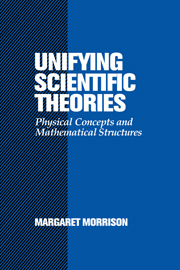Book contents
- Frontmatter
- Contents
- Acknowledgements
- Introduction
- 1 The Many Faces of Unity
- 2 Unification, Realism and Inference
- 3 Maxwell's Unification of Electromagnetism and Optics
- 4 Gauges, Symmetries and Forces: The Electroweak Unification
- 5 Special Relativity and the Unity of Physics
- 6 Darwin and Natural Selection: Unification versus Explanation
- 7 Structural Unity and the Biological Synthesis
- Conclusions
- Notes
- References
- Index
6 - Darwin and Natural Selection: Unification versus Explanation
Published online by Cambridge University Press: 06 October 2009
- Frontmatter
- Contents
- Acknowledgements
- Introduction
- 1 The Many Faces of Unity
- 2 Unification, Realism and Inference
- 3 Maxwell's Unification of Electromagnetism and Optics
- 4 Gauges, Symmetries and Forces: The Electroweak Unification
- 5 Special Relativity and the Unity of Physics
- 6 Darwin and Natural Selection: Unification versus Explanation
- 7 Structural Unity and the Biological Synthesis
- Conclusions
- Notes
- References
- Index
Summary
In the chapters on unification in physics we have seen how mathematics provided the kinds of structures that allowed us to bring together diverse phenomena under a common framework. Yet in both the electrodynamic case and the electroweak case, the additional parameters necessary for the unification (the displacement current and the Weinberg angle, respectively) provided nothing in the way of a substantive explanation of how and why unification processes take place. My point in those chapters has been to emphasize not only the differences between the ways in which theories can become unified but also how the unification process differs from the process of explaining specific phenomena.
Initially one might suppose that this situation would be limited to physics, especially in light of its rather abstract, mathematical form. However, in this chapter and the final chapter I want to show how a unification involving biological theories has many similarities to the unifications in physics, and that many parallel conclusions about the relationship between unification and explanation can be drawn in the two cases. More specifically, I want to show how the most successful unification in biology, the synthesis between evolutionary theory and genetics, was accomplished by applying particular kinds of mathematical structures that enabled early geneticists to bring together natural selection and Mendelism under a common framework. Although a theoretical unity was achieved, there was no agreedupon explanatory model regarding the ways in which selection operated within that new synthesis. In fact, it is still an open question as to how the unification of evolutionary theory with Mendelism, under the structural constraints of population genetics, ought to be interpreted qualitatively.
- Type
- Chapter
- Information
- Unifying Scientific TheoriesPhysical Concepts and Mathematical Structures, pp. 192 - 209Publisher: Cambridge University PressPrint publication year: 2000



